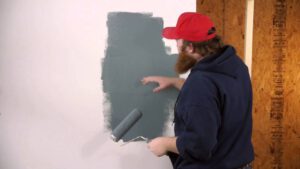Drywall Painting Tips
Drywall painting may seem intimidating, but with a little knowledge and some tips, it can be a fun and easy project.

A good drywall primer helps conceal mud and tape on your drywall walls, so it’s important to use one before you start painting. It also helps the paint dry faster, saving you time and money. For more tips, read on Drywall Repair Las Vegas.
Drywall primers, also called joint compound or spackle sealers, are essential to the painting process. They prepare the drywall and mud for paint, ensuring that the paint will adhere properly and remain on the wall for a long time.
There are a few different types of drywall primers that work for various purposes. You’ll want to choose the type that best fits your needs, such as protecting drywall against moisture or hiding existing stains. You’ll also need to consider the size of the area that you are priming, as well as the volume of product that you will require.
One of the most common drywall primers is polyvinyl acetate or PVA, a substance used in carpenter’s glue that works by sealing the porous surface of drywall and mud so that the paint will stick better to it. Another type of drywall primer is called a latex primer, which provides a smooth finished surface for the paint to adhere to and protects bare walls from small knicks and dings.
Some drywall primers also come in tinted versions, which can make them easier to apply and give your wall a more uniform finish. They can be found at many paint stores, and they may cost an additional fee.
If you are working on a new drywall, a specialized drywall primer-sealer can be the best choice. It will not only cover any imperfections, but it will also seal the drywall and mud to ensure that it is ready for paint.
In addition, some drywall primer-sealers can be tinted to a color that closely matches the finish paint you are going to use. These products cost a bit more than standard sealers, but they can be worth the price in the long run.
Other drywall primers are designed to hide existing stains on the drywall, such as crayon marks or marker pen ink. You can find shellac or oil-based drywall primers that are excellent for this job. Some water-based primers, too, can be formulated to hide stains.
You can also get drywall primers that are specifically designed for indoor surfaces and outdoor surfaces. Interior primers are designed to work on a variety of materials, including wood, drywall, and brick, while outdoor primers are specialized for coating rougher, mildew-prone, or brittle surfaces.
Drywall primers and paints are the essential elements of a drywall painting project. They create a base that will allow the top layer of paint to adhere to the surface properly and provide a consistent look. Without primers, paint jobs can be streaky and unappealing.
Primer-based paints are long-lasting and breathable, stain-resistant, and low-VOC (volatile organic compounds). They are also inexpensive and easy to spread. They can be used on a variety of surfaces, including wood, metal, and concrete.
Water-based drywall primers are a common choice because they are easy to use, low-odor, and environmentally friendly. They also seal fresh drywall well, making them the ideal base for latex paints.
They are available in a variety of colors and textures. They can be applied with a brush, roller, or sprayer. Some painting professionals recommend a sprayer to get a more even coat than with brushing or rolling.
Typically, a textured paint will help reduce dent visibility and reflect less light than a smooth finish. This is especially true when the drywall is in a room that receives little natural light.
A textured paint will also make it more difficult for the eye to identify imperfections on the wall. This is because the textured finish will cause the light to bounce off the surface in different angles and make it harder for the viewer to see flaws.
